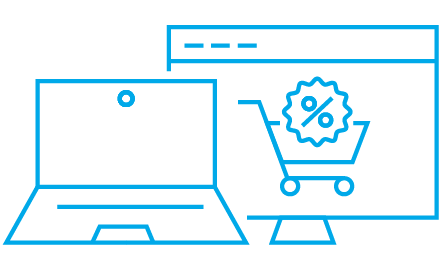- Raw Data - who can benefit the most from data?
- Raw Data Formats
- Raw Data Integration
- Raw Data and GDPR
Raw Data is a feed of information, which can be collected on dedicated platforms, such as Data Management Platform (DMP). It contains raw data that has been extracted from the user’s browser behavior. The data can be used as good source material for ad targeting, predictive research, and Big Data analysis.
Raw Data is an elastic data service so you can adjust its structure according to your business needs. By using Raw Data, you collect all the data via pixel implemented inside the website’s source code. IDs of used data points and segments are saved, e.g. on DMP and then are combined with supplying data, like timestamp, number of occurrences or cookie lifetime along with client or OnAudience.com taxonomy.
Raw Data can be used to observe users’ behavior and compare their characteristics, watch their interests and intentions, and predict future actions so their visit ended up with actual conversion. You can use Raw Data for targeting in programmatic advertising market, building your own data tools, preparing Big Data analysis to improve your product or to making a research before a new product release.
Raw Data – who can benefit the most from data?

Companies of all sizes which have data scientists team in their disposal can gain from raw data the most. Depending on the company’s industry, raw data can be processed according to the business needs. Raw Data enables data science teams to meet data needs, build own data tools, including personalized experience and messaging, recommendation systems and machine learning algorithms.
Raw Data Formats
Raw Data can be provided in various formats. In OnAudience.com it is available in four formats. Each has corresponding attributes, based on a chosen data to be received.
1. Data Point format contains the following attributes:
- number of Data Point occurrences – it shows how many events, such as opening a website or clicking in specific link, was generated by users;
- last user’s activity;
- main user’s country – by traveling, users can be assigned to various countries; main user’s country is the one which occurs most often;
- last timestamp (in UNIX form) represents a time when an event related to specific data point occurred last time;
- cookie lifetime is a period of time when a particular cookie is exchanging between the user’s web browser and server.
2. In Segment format encoded user ID and segment IDs are shared. Included segments belong to the client and represent specific characteristics of web page visitor’s, like interests or demographic data.
3. Hybrid data is a combo of both previous data formats but per particular Data Points. This data is more customizable, so it allows to get more precise information about users, like specific set of interests and demography information.
4. URLs – is a set of information about particular URL that was visited. Following fields are shared out there:
- URL;
- timestamp (in UNIX form);
- userAgent – it’s indicating what type of device was used;
- geolocation;
- short IP address.
There are multiple areas, where aw data itself can be used. It’s good source information to be included in the planning stage of research, during prediction or to test on the final. The most popular fields are:
- Fraud detection & scoring – raw data can be used as source data for an anti-fraud algorithm. For example, timestamp or amount of cookie occurrences or analysis of data points can be used within the scoring system to detect fraud or to make sure that a message receiver is not a bot (so-called Non-Human Traffic).
- Artificial Intelligence – raw data can be treated like a train set and a test set during AI and machine learning algorithms building.
- Raw data can be used for Profiling & personalization to customize client profiles and divide them for segmentation, e.g., per gender or location (based on Data Point). The segments are used in precise targeting of online ads and sending clients personalized messages.
- Business Intelligence – raw data is a source of information for BI systems, that helps to enrich user profiles with more detailed information, e.g., purchase path or geodata. This information is a good material for business analysis and predictive research.
- Targeting – processed data by data scientists can help to improve online campaigns and reach the target audience.
- CRM Enrichment – data can be integrated with the client’s CRM system. CRM integration provides a possibility to fill the gaps by client-side with demographic data, interests or buying intentions into user profiles. So, by enriching CRM systems, clients’ get a full view of their customers, which allows them to send highly personalized messages.
Raw Data Integration
Raw Data can be easily integrated with systems that currently work in companies. The raw data helps to find new insights, improve the quality of data or segment users and deeply know their behavior.
The most common integrations with Raw Data involves Big Data systems, such as Customer Data Platform (CDP), Customer Relationship Management (CRM), Data Management Platform (DMP), Content Management System (CMS) or Demand-Side Platform (DSP).
- Raw Data can be integrated with systems such as CDP, CRM or DMP to enrich client profiles with either personal or anonymous data. You can easily expand the knowledge about existing users by using external sources.
- Raw Data can be used to enrich Business Intelligence systems and make analysis more precise and conclusions more accurate.
- In the case of CMS integration, Raw Data is used to identifying the users and personalize their visit, even if it’s their first. By data analysis, the actual content of the website can be adapted to the user’s preferences.
- Raw Data can be integrated with DSP – a platform that is an important part of programmatic advertising ecosystem. Parties (e.g., advertisers) can exchange the users’ IDs and combine existing profiles with external data to enrich the users’ segments and improve their quality.
- Raw Data might be used to build specific user segments (e.g., people interested in the automotive industry) and use them for targeting online campaigns. Segments can be enriched with more user characteristics out of raw data and then sent to DSP.
Raw Data and GDPR

Raw Data is a flow of data that contains various information. It can include Personally Identifiable Information (PII) but to comply with privacy regulations in the GDPR era companies also provide streams only with anonymous information. What’s more, some of data providers anonymize all the data that flows to the client.
OnAudience.com Raw Data includes only anonymous information and it is fairly enough for targeting purposes, finding valuable insights about online users’ behavior or improving business analysis.



